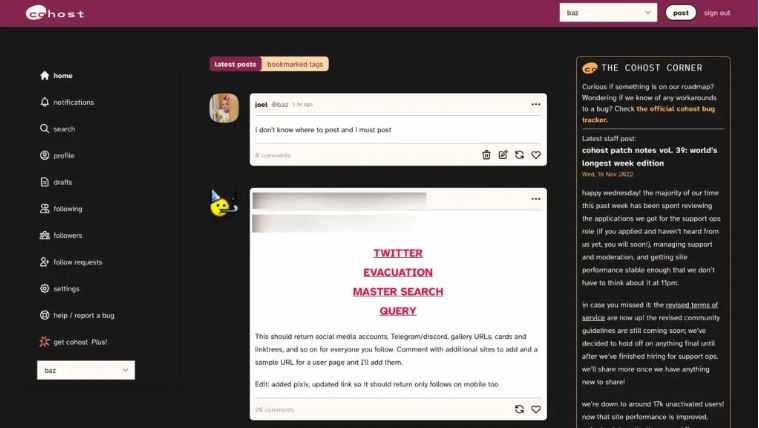Want to know what the best Twitter Alternatives are there to consider? We look at Mastodon and Cohost, as well as others in hopes of a new home.
In the best display of how truly useless he can be, Elon Musk’s takeover of Twitter has completely imploded itself. Razing the land, and removing all but very few people from its roster of staff has destroyed not only one of the most important apps on the planet but the world’s view of itself.
Even if Twitter does survive this onslaught, it’ll never recuperate properly. Comparisons to the end of an MMO or even the many unhinged destructions of forums by their owners in the mid-90s and early-00s have been made. We could honestly go on, and on about how bad this all is.
Though we must soldier forward and we can now start to migrate to other places. The trouble is, it’s been a long time since any of us had to do this. Sure, newer social media apps like TikTok and BeReal have seen quick adoption, but nothing with interpersonal relationships like Twitter.
So it’s no surprise that for the last few years, through the various horrors that have been bestowed upon an unsuspecting public, alternatives have been built.
Twitter failed alternatives: Ello and Pillowfort
We’ve been keeping tabs on them for years now, with very few actually managing to maintain the momentum needed. Ello, a first real attempt, is now more of a Pinterest clone. Pillowfort, which properly came to light in 2021, was kicked to the curb after it was revealed it wasn’t built right.
The two that have managed to cotton on and manage to crash multiple servers, are Cohost and Mastodon. They aim to do the same thing as Twitter, but in wholly different ways.
What is Mastodon?
Mastodon is a Twitter-esque social app, that allows you to join a particular server and interact with other users on the platform. It differs from Twitter in that it requires you to choose a server to start from.
Unlike with Discord or Slack, you’re not limited to that one server. It’s essentially your online house, with the ability to cross the street to see everything just a few clicks away. The major problem at the moment is finding a particular server that’s relatively populated for those without immediate connections from Twitter.

While you can see everything, there’s a definite issue with regards to onboarding. Usernames aren’t just ‘yourusername’, but ‘yourusername@theserver.theendofaurl’. Searching for someone outside of your server requires you to know what server they’re on and what their username is. Without this information, you could wind up following someone else.
However, the web interface is fairly familiar to those already used to Twitter. For those of us who enjoy Tweetdeck’s more in-depth view, there’s an advanced viewing option hidden in the settings.
Mastodon also comes with some great features, like an increased limit to 500 characters and content warning tags. It is quite cringeworthy that they’re called ‘toots’, with the creator of Mastodon, Eugen Rochko revealing that it was the fault of YouTuber Hbomberguy.
How to join Mastodon:
To join Mastodon, you’ll need to sign up and choose a server. Once you’ve decided where you’re going to be posting from, you can then start to follow pretty much anyone.
It’s very easy to get accustomed to its eccentricities. However, a lot of servers are currently taking manual applications. This means you’ll have to wait for a human to let you in. Others, like the mastodon, the social server is currently closed to sign-ups.
You can find ones that are specifically designed for a niche or even ones for your local area. You can move your account over to another server, and even see others via the ‘Federation’ tab.
What is Cohost?
Cohost aims to be a bit simpler than Mastodon, but provides a more robust posting ability. It appears to be building something that doesn’t use advertising, or algorithms to coerce you into seeing things.
The interface is still a little rocky, reminding us of the early days of Twitter, but overall is easy to navigate. It supports markdown, letting you customize your posts to your liking. Alongside this, it lets you indicate whether or not it’s an adult post.

A major problem with Cohost is that there’s no proper search function. The dedication to a lack of algorithm means that it doesn’t feature a trending area. You can search for hashtags to follow, but it won’t surface things to you unless you actively search, or follow people.
If you’re after a one-to-one experience that Twitter brought, this might be the closest you can get in the meantime.
It also will not let you post straight away. In a bid to kill an influx of bots and mallicious users, Cohost has a waiting list before you can post. This might seem counterintuitive, but the time between getting access to the site and the option to post is getting shorter. Also, it means they can easily vet bad actors before they infiltrate the website. That, and save their servers from burning up.
Cohost does allow you to pay a fee to get ‘Cohost Plus‘, which still seems a little thin on offerings outside of helping out the development team keep the lights on.
The future of Twitter

While the site may be in some form of functioning state right now, there’s fears it could collapse with the mass exodus of staff.
Even now, the various apps and even the official homepage are glitching, or slow to load. There’s only so much the site can take before it will metaphorically topple down.
While we believe it won’t permanently vanish, it’s absolutely a new age for the app and one that we don’t think many will stick around to see.
(Via)







